Learn
Glass
Glass evidence is often present at crime scenes involving burglary or a hit-and-run accident. Broken glass may also be found when gunshots are fired, arson, or violent altercations occur. Because it is so common, the value of glass evidence is often overlooked.

By studying the physical properties of glass fragments, scientists can determine
- whether two samples, such as that from the crime scene and suspect came from a common source
- which side of the glass was impacted to cause the break
- which direction a bullet traveled from (inside or outside the window)
- which bullet was fired first if two holes are in close proximity
- if a glass object was shattered due to heat (fire) or force
In each of these cases, the evidence provided is class evidence. Only if the pieces of broken glass can be made to fit together like a jigsaw puzzle can a positive individual match be made.
Before glass evidence can be examined, it must be properly collected and labeled. The collection methods differ depending on whether the glass fragments are large, visible fragments or smaller, microscopic fragments.
Open the Indiana State Police Laboratory Division's Physical Evidence Bulletin on Glass and read the section "Collection, Preservation, Marking and Transportation of Glass."

Knowledge Check #1
Small glass fragments may be found on articles of clothing or shoes. Which of the following is the proper procedure for collecting and packaging a shoe with glass fragments on it?
- Use tweezers to remove the glass fragments into a small container and seal
- Place the shoes into a container with no holes that debris could fall through
- Pack the shoes with cotton to protect the glass and place in a cardboard box of adequate size
Answer: b. Place the shoes into a container with no holes that debris could fall through
Knowledge Check #2
To determine the direction of impact, you must record _______blank.
- which side of the glass was facing down and which was facing up
- which side of the glass was on the outside of the window and which side was on the inside
- which side of the glass had more cracks
Answer: b. which side of the glass was on the outside of the window and which side was on the inside
Knowledge Check #3
Laboratory examination of glass samples is almost exclusively a process of ________blank. Therefore, as many fragments as possible must be collected from all possible sources. For example, in a car accident where multiple windows and a headlight are broken, glass should be collected from ________blank one.
- comparison; only
- comparison; each
- individualization; only
- individualization; each
Answer: b. comparison; each
Physical Properties of Glass
Once the glass arrives at the lab, its various physical properties may be studied. If large fragments are available, investigators will begin by trying to piece them together to determine the original shape and dimensions of the glass. Further examinations are described below. Note which tools, if any, are required for these examinations.
Color
Glass fragments are placed on a white background in natural light. Similarly-sized fragments are placed side-by-side for color comparison.
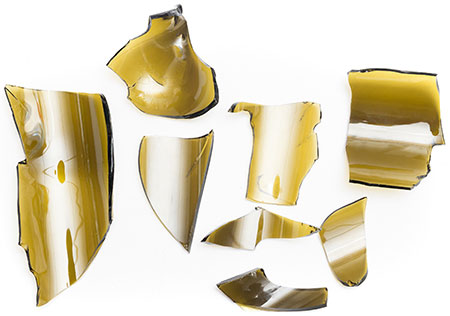
Florescence
Some types of glass will fluoresce, or shine or glow brightly, due to the presence of some materials in the glass, such as uranium, or the process by which it was produced. A UV light is shone on the glass to check for florescence.
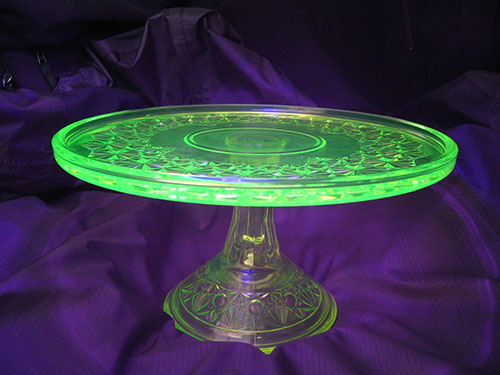
Curvature
Whether glass if flat or curved can be evaluated using low-power magnification, such as a microscope.
Surface Characteristics
The surface characteristics of glass can be unique and useful in examining glass evidence. Surface characteristics may include:
- scratches,
- marks from production, or
- decorative elements such as etching or frosting.
These may be evaluated with the naked eye or stereoscopic microscope.
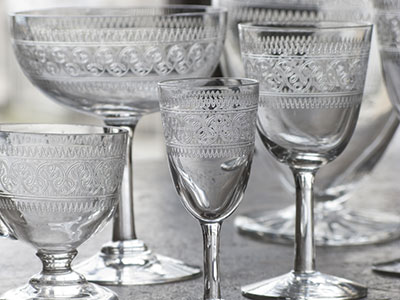
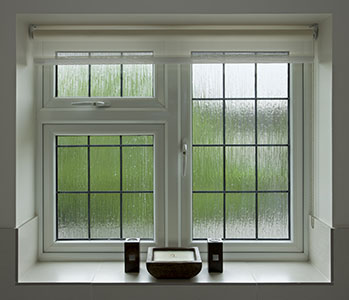
Density
Density is the relationship between the mass (measure of how much matter is in an object) and the volume (measure of how much space an object takes up) of an object.
Density is an intensive property of matter. Intensive properties do not change even when the size of the sample changes.
For example, if a window breaks into 1,000 pieces, some pieces will be larger and have greater mass and volume. Some pieces will be smaller and have less mass and volume. However, ALL pieces will have the same density. The calculation of density is, therefore, useful in determining if pieces of glass came from a common source.
Calculating Density
To calculate density, the mass of the substance is divided by the volume.
Density = mass/volume
Example: Calculate the density of a shard of glass with a mass of 84 grams and a volume of 44 mL.
- d = ?
- m = 84 grams
- v = 44 mL
Plug the known values into the density formula and solve.
- d = m/v
- d = 84 g/44 mL
- d = 1.9 g/mL
Knowledge Check #4
Determine the density for the following samples of glass and match them to their source. Note: there are three samples and four types of glass; one of the types of glass will not match to a sample.
Samples:
- Sample 1 (Mass: 72.5g; Volume: 29mL)
- Sample 2 (Mass: 49.6g; Volume: 16mL)
- Sample 3 (Mass: 53.9g; Volume: 22mL)
Types of Glass:
- Bottle glass (Density = 2.4 g/mL)
- Window Glass (Density = 2.5 g/mL)
- iPhone Screen (Gorilla Glass) (Density = 2.45 g/mL)
- Lead Crystal Vase (Density = 3.1 g/mL)
Answers:
- Sample 1: Window Glass
- Sample 2: Lead Crystal Vase
- Sample 3: iPhone Screen (Gorilla Glass)
- No sample matched: Bottle glass
Does It Sink or Float?
The easiest way to observe density is to see if something floats or sinks. If a solid sinks when placed in a liquid, it is denser than the liquid. If it floats, it is less dense than the liquid. However, if the solid remains suspended in the liquid, the densities are approximately the same.
Knowledge Check #5A
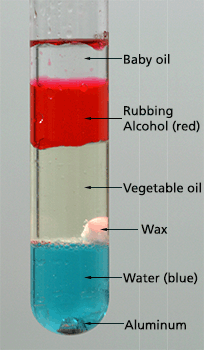
In the column above, the wax has a density between that of ________blank and ________blank.
Answers: vegetable oil; water.
Knowledge Check #5B
According to the density column, the aluminum is ________blank dense than the other substances.
Answers: more
Density and Flotation
Scientists may determine the density of glass by measuring mass and volume. More commonly a special method known as flotation is used.
- Glass particles are immersed in a liquid.
- The density of the liquid is adjusted until the glass is suspended.
- When the glass is suspended, it has the same density as the liquid.
Refractive Index
Light bends or refracts when it moves from one medium to another. This is the reason this pencil appears to break at the point where it enters the water.
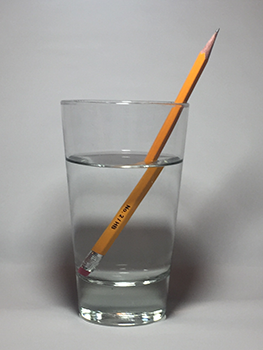
The amount of "bend" that a substance causes when light enters it is known as the Refractive Index, or RI. It is measured by dividing the velocity of light in a vacuum by the velocity of light in that substance. Substances with a greater refractive index cause the light to slow and bend more than substances with a smaller refractive index.
The refractive index of glass depends on both the materials and methods used to make the glass. Refractive index is another intensive property and can be used to match glass samples to a common source.
Determining RI
A method for determining the refractive index of glass is like the one for determining density.
- The glass is placed in a sample of liquid.
- If the substances have different refractive indexes, bright halos will appear near the border of the glass. These are known as Becke Lines. ("Becke" sounds like the name "Becky".)
- At this point, the refractive index of the liquid is the same as the refractive index of the glass.

Fracture Patterns
Cracks in glass occur when a force is applied that exceeds the limits that the glass can withstand. Two types of cracks can form: radial fractures or concentric fractures.
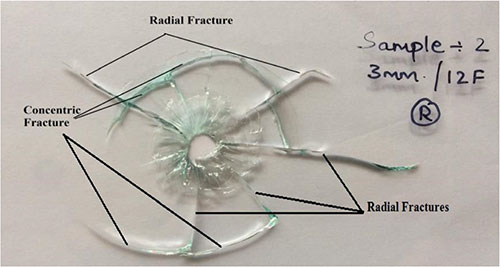
Radial fractures radiate outward from the point of impact like spokes on a wheel. They form on the side of the glass opposite the impact.
Concentric fractures form a circular pattern around the point of impact. They form on the same side of the glass as the impact.
Studying these fracture patterns can help investigators determine the speed and direction of impact.
Which Impact Came First?
If more than one impact location is present, it is also possible to determine the order in which these impacts (such as bullet holes) occurred. This is done by seeing where the fracture patterns intersect. New fracture patterns will always terminate when they encounter an existing fracture, rather than crossing over it.
Note that the radial lines from B run stop when they encounter the radial lines from A. This indicates that bullet hole A was created first.

Knowledge Check #6
Which of these bullet holes was created first?
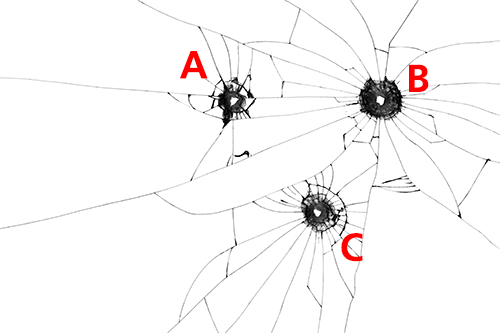
- A
- B
- C
Answer: b. B
Credits
Harshey, Abhimanyu, et al. "Analysis of Glass Fracture Pattern Made by .177″ (4.5 Mm) Caliber Air Rifle." Egyptian Journal of Forensic Sciences, vol. 7, article 20, 2017, doi:10.1186/s41935-017-0019-5. Work is licensed under CC BY 4.0.
"Properties of Physical Evidence" from the Forensic Science course by Georgia Virtual Learning (OER) is licensed under CC BY 3.0.